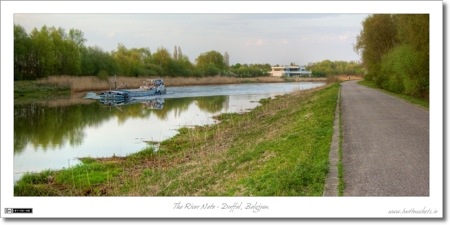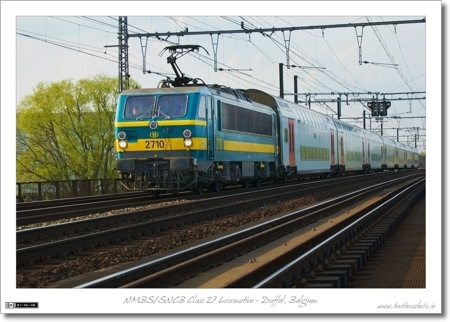May
20
Photo of the Week 65 & 66 – Transportation in Duffel, Belgium
Filed Under Photography on May 20, 2009 at 8:42 pm
Since I’m going to be away next weekend I’m combining this week’s photo of the week with next week’s to give yet another double-installment. As always when I combine two weeks into one, I’ve chosen a theme to unite both shots, in this case, transportation in the Belgian village of Duffel (my birthplace). In some ways these images span centuries. The first is of a heavily laden barge powering down the navigable river that passes through the village, the Nete. The Nete was the best transport link to the village for centuries, if not millennia! The second shows a train on the main line between Brussels and Antwerp which passes through Duffel. This is not the very oldest railway line in continental Europe, but it’s very close, being an extension of the very first one which ran from Brussels to Mechelen. That historic first section of what is now the line form Brussels to Antwerp opened on the 5th of May in 1835, while the remainder of the line, including this section in Duffel, opened a little less than a year later, on the 3rd of May in 1836.
Although Duffel is about 100km from the sea, Belgium is so flat that the Nete is still a tidal river as it passes through Duffel. In fact, at high tide many parts of the village are below the level of the river! For this reason the river is bordered by large dikes on both sides. These dikes are now paved, and serve the local communities as cycle and walking routes. It’s just north of Duffel that the river Nete now connects to the Nete Canal which brings shipping traffic up to the Albert Canal. Because of low bridges and the tidal nature of the river in Duffel, larger boats can only navigate the river at some times of the day, the water being too shallow at low tide, and the bridges too low at high tide. Smaller barges can navigate the river at any time without fear of running aground or crashing into bridges. In this shot we see a barge called Despatch making its way down-stream towards the village of Duffel at the very peak of high tide. As you can see by how low the barge is in the water, she’s clearly fully loaded, probably with coal, sand, or gravel. This kind of barge is low enough to pass under the bridges even at high tide.
- Camera: Nikon D40
- Lens: Nikon DX AFS 18-55mm (D40 kit lens)
- Exposure: 1/320 sec
- Focal Length: 40mm
- Focal Ratio: f/5
- ISO: 400
- Camera Mode: Aperture Priority
- Processing: lightly tonemapped in Photomatic Pro, then the barge was lightened slightly using Aperture’s Dodge & Burn plugin
My second chosen shot is of an evening express service from Antwerp to Brussels crossing the rail bridge over the Nete a little down-stream of Duffel village. This train is making its way along the same track bed that the first train between these two cities ran on way back in 1836. To put that into context, trains have been running here since 60 years after the (US) declaration of Independence. This train is made up of the best coaching stock the NMBS (Belgium’s national railway company, also know as the SNCB) has to offer. These M6 carriages give travellers two decks full of creature comforts on their short and speedy journey between Belgium’s two largest cities. The locomotive pulling the train is an NMBS Class 27 electric locomotive. Although these locomotives are approaching 30 years of age, they are still in fine condition and more than up to the task of whisking passengers between Belgian cities at speeds of up to 160km/h.
- Camera: Nikon D40
- Lens: Nikon DX AFS 18-55mm (D40 kit lens)
- Exposure: 1/500 sec
- Focal Length: 55mm
- Focal Ratio: f/5.6
- ISO: 400
- Camera Mode: Aperture Priority
- Processing: lightened the train a little using Aperture’s Dodge & Burn plugin








